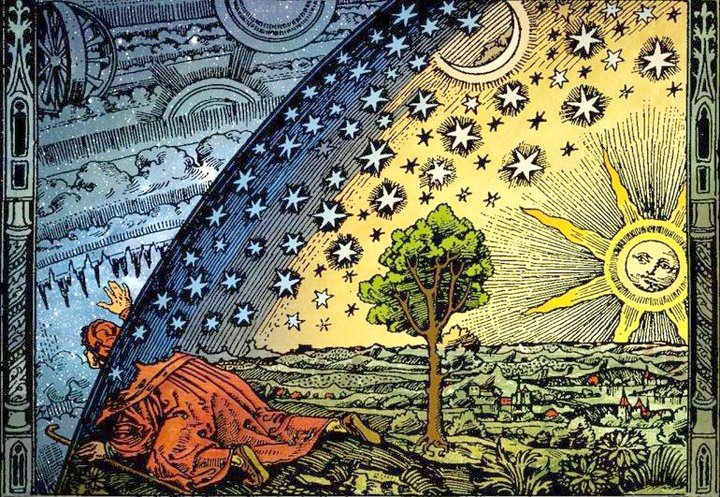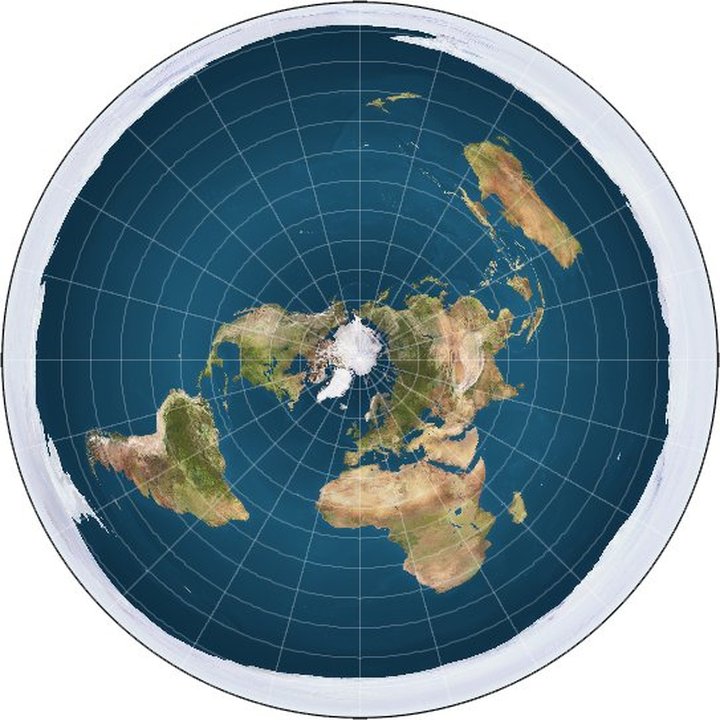The myth, of course, is that the spherical planet on which we live isn’t. Instead it’s a disk, sitting underneath a dome of sky. Beneath it’s a bit of a mish-mash. The first, the very first record—ten-inch shellac—that I owned was Christopher Columbus whose lyrics, sung by Guy Mitchell, went:
Queen Isabella she gave heed
Said, “Go buy the ships you need.
Take my jewels but travel slow
Cos you might fall down to the world below!”
At an impressionable seven years old, the words had their impact. Everyone except our hero Christopher (the same who, as I would later learn, set an enormously high bar for committing atrocities against native “Americans”) believed the Earth to be flat back then.

The “Flammarion engraving” shows a medieval pilgrim discovering where heaven and Earth meet. From Camille Flammarion’s L’atmosphère: météorologie populaire (1888). (Public domain)
The story of Columbus and his contrary belief in a round Earth was promulgated by, among others, Washington Irving. Having already made his name with The Legend of Sleepy Hollow and Rip Van Winkle, Irving hit writer’s block and, like many more suffering that ailment, before and since, went to Europe to cure it. Somehow—it’s a long story—he ended up living in the Alhambra Palace in Granada, Spain, where an elegant plaque testifies to his sojourn. Fired up by the environment (if the Alhambra doesn’t cure your writer’s block, nothing will, it’s gorgeous) he wrote a biography of the man who diskovered America (14,000 years late): A History of the Life and Voyages of Christopher Columbus.
Except it wasn’t. A biography, I mean. It was, to put it kindly, “historical fiction.” Especially where it referred to the topic of this column. According to Irving, Columbus had to convince the Spanish intelligencia—in particular a commission set up by King Ferdinand and Queen Isabella to evaluate Columbus’ proposed voyage and decide whether it was worth financing. He—Columbus—had to overcome Biblical objections raised by ignorant members of the commission that the Earth wasn’t a sphere, that it was flat, that’s what the Bible said. Isaiah 40:22; Matthew 4:8.
It’s all bullshit, of course. No educated European, to all intents and purposes, believed in a flat Earth at the time of Columbus. The Earth had been known to be spherical since at least the time of the ancient Greeks. Around 200 BC, Eratosthenes of Cyrene, chief librarian at the Library of Alexandria, famously calculated Earth’s circumference by comparing the length of noon-day shadows at two distant locations. (He got it right to at least within 15%, perhaps even 2%, depending on several assumptions we can now make about his units.)
So what’s with the flat Earth myth? Following Washington Irving’s fable (and a couple of other lesser-known writers), the myth took hold in the years following publication of Charles Darwin’s Origin of Species—that is, when there was a very real conflict between science (the Earth is billions of years old, “advanced” species are a natural outcome of evolution) and literal-interpretation Christianity (young earth, divine creation of species). “Flat Earthers” became a derogatory term used by atheists and agnostics for dogmatic believers. Here’s how historian Jeffrey Russell puts it, per Wikipedia: “…the flat-Earth error flourished most between 1870 and 1920, and had to do with the ideological setting created by struggles over biological evolution.”
Although the flat-Earth dispute is usually portrayed as atheists vs. Christians, it’s also been characterized as Protestants vs. Catholics—just two years ago, ex-Catholic priest Thomas Groome said, “The Catholic Church never said the world is round but just stopped saying it was flat.” I tried, unsuccessfully, to find more references to “dumb flat-Earth-believing Catholics” but couldn’t, thankfully. I suspect that particular meme has as much credibility as Irving’s fable about medieval flat-Earthers.

To you, (I hope) it’s an azimuthal equidistant projection of a spherical Earth. To a Flat-Earther, it’s a disk-shaped Earth surrounded by a high wall of ice—what most of us would call “Antarctica.” (Trekky0623/Public domain)
Not
that flat-Earthers aren’t alive and well today!
Despite: (1) ships disappearing over the horizon; (2) round Earth
shadow on the moon during a lunar eclipse; (3) photographs of Earth
from space; (4) orbital GPS satellites helping to navigate cars,
ships and planes; (5) time zones—when I talk to my sister in the UK
at 3 pm here, the sun’s already set there; (6) the sun is higher in
the sky at noon the closer to the equator you go…and
etcetera—despite all that, there is today an “official” Flat
Earth Society. Actually, three of them, at least, to add to my list
of nutters (see here).
Sun’s out, time for a paddle on the bay, the water looks really calm, really flat. Too flat?
CLICK TO MANAGE